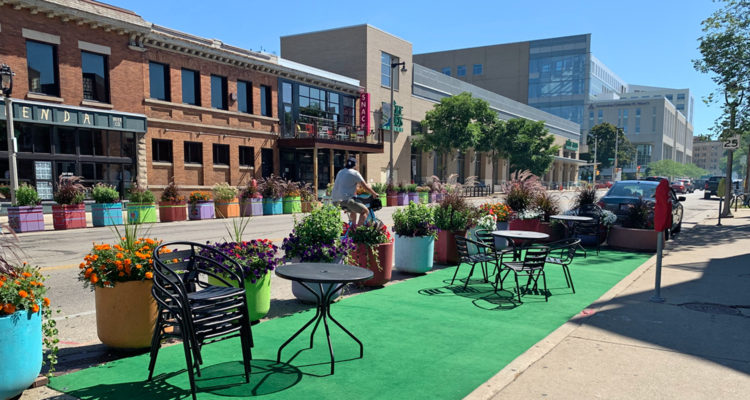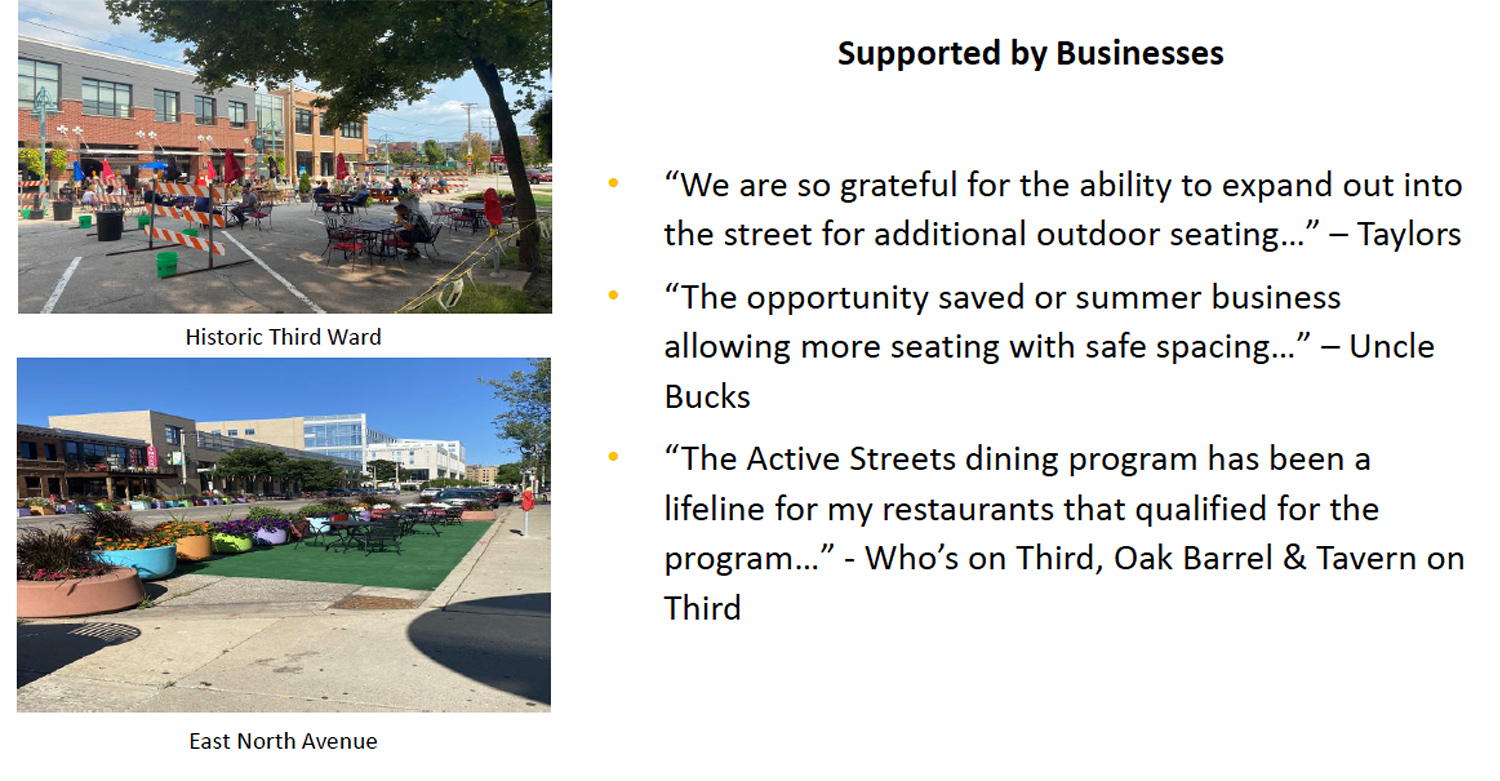Want to dine outdoors at your favorite restaurant in the dead of winter? Bundle up, Milwaukee, because you just might get the chance.
Back in June, the Common Council passed the so-called “Active Streets for Business” program. The program gave Milwaukee bars and restaurants options to expand outdoor seating into nearby sidewalks and parking lanes. It was set to expire in November. With no end in sight for the COVID-19 crisis, however—and, in fact, with things getting worse—that program will likely be extended through the fall and winter, to at least March 15, 2021.
The Public Works Committee approved both the extension of the program and a set of fall and winter guidelines at a meeting Wednesday morning. The matter still needs approval from the full Common Council. The Common Council meets next on November 4.
The fall and winter guidelines allow businesses to submit plans to build temporary outdoor structures such as tents or domes in the public right of way. At least 50% of the total wall space of these structures needs to be open for air flow, and all structures must be secured to the ground without any screwing, cutting, or drilling into the sidewalk or street.
Heating equipment is allowed. Electric heaters must be installed by a licensed electrical contractor, and natural gas heaters are only allowed in uncovered sidewalk areas, and not in the road.
What about snow removal? The fall and winter guidelines stipulate that “restaurants/bars will need inclement weather plans in writing and trained staff to prevent injuries in storms, snow or other unsafe situations.”
The initial program and its extension are sponsored by Alderwoman Marina Dimitrijevic. “We heard from business owner after business owner that this is going to be helpful,” she said on Wednesday.
In an earlier press release, Ald. Dimitrijevic further explained her intentions with the program.
“Active Streets for Business was a way to support the food service industry, ensure patrons remain safe while dining at their favorite establishments, and an opportunity to create public gathering spaces for neighborhoods to come together during these difficult times,” Ald. Dimitrijevic said. “The program thus far has proven to be a success, and I want to allow bars and restaurants to maintain this momentum so they can have every chance possible to succeed during this pandemic.”
But what about money? Could the cost of building these structures be eventually passed down to the consumer? That’s what Alderman Mark “Wet Blanket” Borkowski wondered at Wednesday’s meeting.
“I don’t want to be a wet blanket, and I think it’s great that we’re making these attempts, but I also want us to be realistic and say that this is not the panacea,” Ald. Borkowski said. “I think once people realize that, okay they can go out, but all of a sudden the dining experience is costing more. There’s going to be that point where people say, you know what, I can’t afford it any more. […] All I see are these costs molding, and those costs have to be given back to the consumer. We just need to be cautious about that.”
Here are the full fall and winter guidelines, followed by a slideshow presented at Wednesday’s meeting.
City of Milwaukee
Active Streets for Businesses Program
Fall and Winter Guidelines
Structures
Temporary outdoor structures, including tents, are allowed in the public right of way under the following regulations:
• Temporary outdoor structures must have at least 50% of the total wall space open to allow air flow
• Enclosed structures, such as plastic domes, may be used for individual parties and must have adequate ventilation to allow for air circulation
• Temporary structures must be weighted, anchored or secured to the ground, but cannot be anchored with any method that requires screwing, cutting or drilling into the public way (i.e. streets or sidewalks)
• All structural materials should have fire resistant certification or flame certification showing material is fire-rated or noncombustible
• Use of tents and other temporary structures may be deemed unsafe and prohibited during severe weather events (wind, snow, etc.)
Heating Devices
Heating Devices are allowed but must meet the following operational regulations:
• Heating equipment must be shown on the site plans submitted with the permit application
• Electrically-powered heating devices are permitted; they must be installed by a licensed electrical contractor, who will obtain an electrical permit. Electrical heating equipment must be marked “UL listed” or “UL classified”
• Natural gas heaters or any devices fueled with propane are only allowed in open, uncovered sidewalk areas. No propane devices will be allowed in the roadway.
• Applicants should follow any recommended safety guidelines issued with specific product (see the product’s operations manual)
• Heating equipment should be unplugged or disconnected or overnight storage, and employees should be trained in proper installation of fuel tanks and in detecting leaks
• Establishment should maintain clearance between heaters and all other objects, including tent sides. Required minimum clearance distance depends on the heating device; three feet is recommended
• Cords or materials to power or fuel heating elements should create tripping hazards or violate ADA guidelines
• Patrons must not interact with heater
Safety Considerations
Follow these additional safety considerations to ensure responsible operations:
• Outdoor spaces with heating devices must keep devices away from combustible materials, such as tents, at all times
• Enclosed areas with heating devices must have clearly marked entrances and exits
• Businesses must have sufficient fire extinguishers to cover indoor and outdoor spaces
• Restaurants/Bars will need inclement weather plans in writing and trained staff to prevent injuries in storms, snow or other unsafe situations






